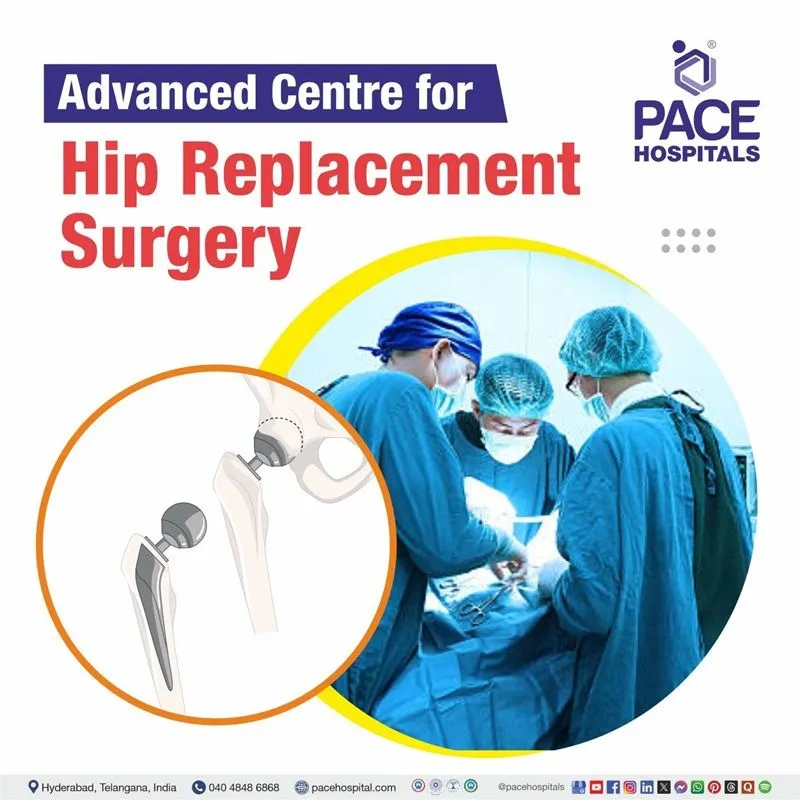
PACE Hospitals is the One of the best hospital for knee replacement surgery in Hyderabad, Telangana, India, offering world-class total and partial knee replacement procedures. Our experienced orthopedic surgeons specialize in advanced robotic and minimally invasive techniques, ensuring Faster recovery, Minimal pain and discomfort, Long-lasting results.
We are equipped with The World’s First Universal Surgical Robotic System, along with a state-of-the-art facility and latest technology, providing comprehensive treatment for knee pain and arthritis, Complex bone and joint diseases, minimally invasive knee replacement surgeries including Total Knee Replacement (TKR), Kneecap Replacement (Patellofemoral Arthroplasty), Partial (Unicompartmental) Knee Replacement (PKR), Revision or Complex Knee Replacement.
What is Knee Replacement Surgery?
Knee replacement surgery, commonly termed knee arthroplasty, is a surgical procedure used to resurface a damaged or injured knee due to arthritis. During the surgery, the damaged part of the knee is replaced with artificial parts, known as implants or prostheses.
This procedure may be recommended for people with severe arthritis, osteoarthritis, rheumatoid arthritis or a severe knee injury that cause chronic pain and difficulty in movement. Knee replacement surgery is generally performed by orthopedic surgeons
Different Types of Knee Replacement Surgeries
Knee replacement surgeries are classified according to the extent of the knee joint that are involved and the type of prosthesis utilized. Below are the primary types:
Types of knee replacement operation
Different types of knee replacement surgery based on the extent of the knee joints that are involved comprise the following:
- Total knee replacement (TKA): This is the most common type of knee replacement, which replaces both joint surfaces (tibiofemoral joint). Artificial components are placed in place to replace the femur (thigh bone) and tibia (shin bone). Most total knee replacement surgeries retain the patellofemoral joint (kneecap). If there is arthritis at the back of the kneecap, the surgeon may also choose to resurface and replace it.
- Partial knee replacement or partial knee arthroplasty (PKA): If arthritis affects only one compartment and the other compartments are normal, the surgeon may recommend a uni-compartmental replacement. This involves replacing only the affected compartment.
- Total knee replacement with kneecap – patellofemoral arthroplasty: The patellofemoral joint that joins the kneecap to the thigh bone can be resurfaced and replaced. This type of knee replacement is less common and only needed if the back of the kneecap is worn off. If necessary, this can be done during a total knee replacement.
- Complex or revision knee replacement: If a patient has had a knee replacement for a long time or is experiencing difficulties, the surgeon may consider revising the joint. This is where the existing components are removed and replaced with a new second joint. For complex knee replacements, surgeons may employ a longer component in the bone to ensure correct implantation.
Types of knee replacement prostheses
Total knee replacement surgery can involve different prostheses. The most suitable form will depend on parameters such as ligament stability, bone and muscle condition, and any misalignments (bowlegs or knock knees):
- Non-constrained prostheses: The upper and lower parts of the prostheses are not joined. For this type of implant to function, the medial and lateral ligaments (and, in certain cases, the posterior cruciate ligament) must be stable enough to coordinate the movements of the knee, such as bending, straightening, and rotating it properly. Most prostheses require the anterior cruciate ligament to be removed before implantation.
- Semi-constrained prostheses: These prostheses are used when the posterior cruciate ligament is unstable and needs to be removed. In these prostheses, a type of hinge connects the two components, providing stability in place of the cruciate ligaments. The hinge determines how far the knee implant can bend and straighten.
- Constrained (or “hinged”) prostheses: A hinged mechanism connects the upper and lower leg components, which are then joined to the bone on each side by a long stem. Constrained prostheses are utilized when the medial and lateral ligaments are insufficiently secure. Other causes include poor bone health and significant misalignments (knock knees or bowlegs).
Why Choose PACE Hospitals for Knee Replacement Surgery?
· State-of-the-Art Advanced Computer-Navigated Surgeries
· Team of the Best Orthopedic Surgeons in Hyderabad
· Knee Joint Replacement Surgery with 99.9% Success Rate & Faster Recovery
· Affordable & Cost-effective Knee Replacement Treatment with Insurance Coverage
Conclusion
When it comes to Knee Replacement Surgery in Hyderabad, Telangana, India, PACE Hospitals stands out as a trusted center of excellence. With a team of highly experienced orthopedic surgeons, advanced surgical techniques, and world-class infrastructure, PACE Hospitals ensures precision, safety, and faster recovery for every patient.
From minimally invasive knee replacement procedures to personalized rehabilitation plans, patients receive comprehensive care tailored to their individual needs. The hospital prioritizes patient comfort, transparent communication, and clinical excellence at every step of the journey.
Whether you’re suffering from severe arthritis, chronic knee pain, or joint stiffness that limits your mobility, Best Multi-Super Speciality Hospitals near me offers one of the best knee replacement services in Hyderabad — helping you regain your movement and improve your quality of life.
✅ Advanced Technology
✅ Expert Orthopedic Team
✅ Patient-Centric Approach
✅ Affordable & Transparent Pricing
Take the first step toward a pain-free future with confidence at PACE Hospitals – Where Healing Meets Excellence.